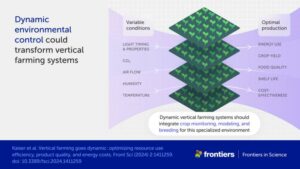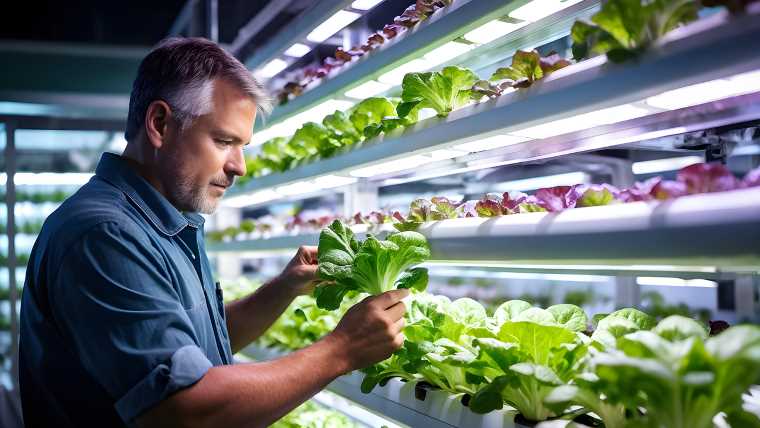A team of scientists from the Netherlands has shown how improved efficiencies in vertical farming can help future-proof the planet against the increasing demand for food caused by a rising world population.
Previous research has shown how the climate-controlled environment of vertical farms allows for growing food in places where the environment makes traditional farming difficult or even impossible. Unfortunately, maintaining the optimum growing conditions within a vertical farming system can be resource-intensive, especially regarding electricity.
Now, the Dutch scientists say their experiments showed how to reduce these power needs by as much as 12% without affecting the quantity or quality of the food produced by vertical farming systems. The team also says their approach can help vertical farmers focus on the taste and quality of food instead of the longer shelf-life preferred in traditional farms due to the long distances that often exist between farmer and consumer.
“The biggest benefit of vertical farming systems is that healthy food can be grown much more closely to consumers in places where this is impossible otherwise: in mega-cities, in deserts, and in places that are cold and dark during large parts of the year,” said Dr. Elias Kaiser, the first author of the article outlining the team’s new approach. “The biggest challenge is the costs associated with electricity use.”
Reducing Electricity Increases the Value of Vertical Farming
The team started their effort to reduce the electricity used in vertical farming systems by analyzing the patterns plants typically experience in nature. This approach revealed that unlike vertical farms, where the environment is precisely monitored and controlled around the clock to improve quality and production, many plants could perform in varied, even sporadic environments.
“We were motivated by the rhythms that plants show on diurnal as well as on developmental timescales, which require their growing environment to be adjusted regularly in order to steer their growth perfectly,” said Prof Leo Marcelis of Wageningen University, the article’s senior author.
Inspired by this natural cycle, the team created a computer model to test different vertical farming that kept the plants thriving while reducing their electricity usage. Specifically, they focused on adjusting light levels at various times and lower intensities so that the plants could still photosynthesize throughout the day while using significantly less energy.
Next, they tested their new approach on actual spinach plants since spinach is a common crop produced by current vertical farming systems. According to the researchers, their customized lighting approach resulted in a 12% electricity savings and found “no negative effect” on spinach production.


The team also found that their plants continued to thrive even when exposed to irregular light patterns. This result indicates that the closed environment of a vertical farm allowed the team to offer the maximum simulated sunlight cycle during times of the daily cycle when energy costs were lower.
“Fluctuations in electricity prices can be used to the advantage of vertical farming systems by using more electricity when it is cheaper,” explained Marcelis.
The team also experimented with different temperatures and CO2 concentrations that are easier to regulate in a vertical farm than a traditional one. Like the benefits of adjusting light levels, the researchers say that vertical farmers might also realize additional cost savings by reducing the power needed to maintain optimized temperatures without reducing plant quality and production.
“We outline a strategy that makes use of plant physiology knowledge, novel sensing and modeling techniques, and novel varieties specifically bred for vertical farming systems,” Marcelis said.
Scaling Energy Improvements Is Critical
Although the team’s work showed that manipulating the lights, temperature, and CO2 present in the plant’s environment reduced costs without reducing produce volume and quality, they say their work was limited in scope and that more studies that try to scale their observed benefits will be required before it can be adapted to large-scale vertical farming systems.
“Many of the proposed solutions have not been tested at the larger scales that vertical farms represent—they may have been shown at the single-plant level, but not yet at the whole crop stand level,” said Kaiser.
“In a vertical farm all growth conditions can be exactly controlled, which is very important to optimize yield, quality, and resource use efficiency,” Marcelis adds. “However, the technical possibility of keeping them constant does not mean that keeping them constant is the best solution. Once dynamic environmental control has become established, both the energy use and costs of the used energy can be substantially reduced, increasing the profitability and sustainability of vertical farms.”
The Study “Vertical farming goes dynamic: optimizing resource use efficiency, product quality, and energy costs” was published in Frontiers of Science.
Christopher Plain is a Science Fiction and Fantasy novelist and Head Science Writer at The Debrief. Follow and connect with him on X, learn about his books at plainfiction.com, or email him directly at christopher@thedebrief.org.

